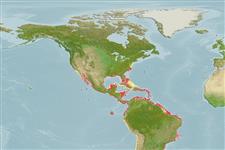>
Eupercaria/misc (Various families in series Eupercaria) >
Gerreidae (Mojarras)
Etymology: Eucinostomus: Greek, eu = good + Greek, kyon = dog + Greek, stoma = mouth (Ref. 45335).
More on authors: Baird & Girard.
Environment: milieu / climate zone / depth range / distribution range
Ecologia
marinhas; Água doce; estuarina associadas(os) a recifes; intervalo de profundidade 0 - 12 m (Ref. 5227). Subtropical; 41°N - 30°S, 120°W - 34°W
Eastern Pacific: Anaheim Bay in southern California, USA southward to Peru, including the Galapagos Islands. Western Atlantic: New Jersey, USA and Bermuda through the Gulf of Mexico and the Caribbean to southeastern Brazil (Ref. 7251).
Comprimento de primeira maturação / Tamanho / Peso / Idade
Maturity: Lm 12.8 range ? - ? cm
Max length : 21.2 cm TL macho/indeterminado; (Ref. 102462); common length : 15.0 cm TL macho/indeterminado; (Ref. 3722); peso máx. publicado: 119.66 g (Ref. 102462)
Espinhos dorsais (total) : 9; Raios dorsais (total) : 10; Espinhos anais: 3; Raios anais : 8. Tip of dorsal fin dusky. Premaxillary groove continuous but narrow, bordered by scales anteriorly (Ref. 26938).
Found over soft bottoms of bays and shallow inshore areas, often along sand beaches (Ref. 2850). Enters freshwater (Ref. 7251). Juveniles are encountered in lagoons of mangroves. Omnivorous (Ref. 9303). Marketed fresh but not highly esteemed; processed into fish meal and used as live bait in the snapper fishery (Ref. 3722).
Ciclo de vida ou comportamento de acasalamento
Maturities | Reprodução | Spawnings | Egg(s) | Fecundities | Larvas
Eschmeyer, W.N., E.S. Herald and H. Hammann, 1983. A field guide to Pacific coast fishes of North America. Boston (MA, USA): Houghton Mifflin Company. xii+336 p. (Ref. 2850)
Status na Lista Vermelha da UICN (Ref. 130435)
Ameaça para os humanos
Harmless
Uso pelos humanos
Pescarias: pouco comercial; isca: occasionally
Ferramentas
Relatórios especiais
Baixar XML
Fontes da internet
Estimates based on models
Preferred temperature (Ref.
123201): 20.6 - 28.3, mean 27 °C (based on 1053 cells).
Índice de diversidade filogenética (Ref.
82804): PD
50 = 0.5010 [Uniqueness, from 0.5 = low to 2.0 = high].
Bayesian length-weight: a=0.00977 (0.00825 - 0.01157), b=3.08 (3.04 - 3.12), in cm total length, based on LWR estimates for this species (Ref.
93245).
Nível Trófico (Ref.
69278): 3.2 ±0.1 se; based on diet studies.
Resiliência (Ref.
120179): Elevada, tempo mínimo de duplicação da população menor que 15 meses (Preliminary K or Fecundity.).
Fishing Vulnerability (Ref.
59153): Low to moderate vulnerability (25 of 100).
Nutrients (Ref.
124155): Calcium = 51.4 [19.0, 111.5] mg/100g; Iron = 0.642 [0.289, 1.253] mg/100g; Protein = 20.1 [18.1, 22.1] %; Omega3 = 0.216 [0.105, 0.433] g/100g; Selenium = 9.44 [4.21, 20.40] μg/100g; VitaminA = 54.2 [13.4, 206.5] μg/100g; Zinc = 1.2 [0.7, 1.9] mg/100g (wet weight);
